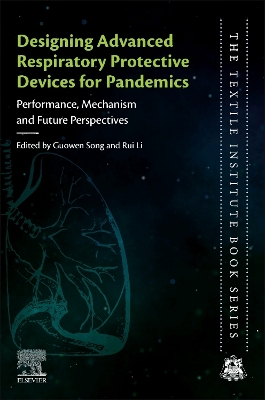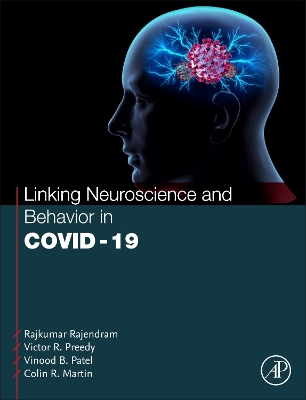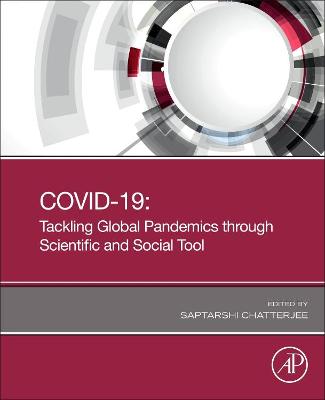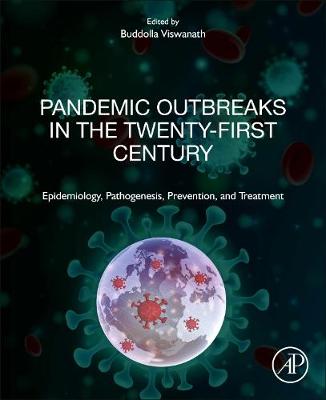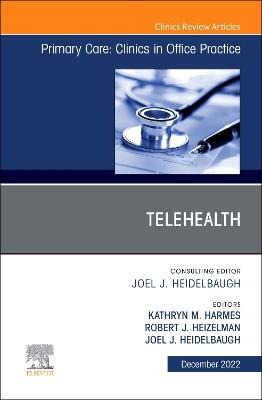Features, Transmission, Detection, and Case Studies in COVID-19
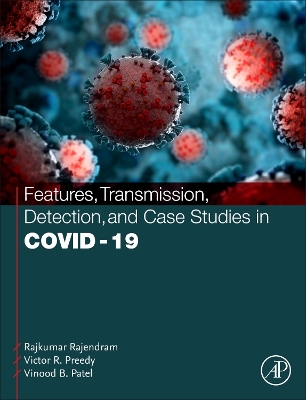 -10%
portes grátis
-10%
portes grátis
Features, Transmission, Detection, and Case Studies in COVID-19
Preedy, Victor R; Rajendram, Rajkumar; Patel, Vinood
Elsevier Science & Technology
07/2024
694
Dura
Inglês
9780323956468
15 a 20 dias
Descrição não disponível.
Section A: SARS-CoV-2 and COVID-19: Introductory chapters and setting the scene
1. Coronavirus disease 2019 (COVID-19) pandemic in context: Systemic effects
2. Early warning of SARS-CoV-2 infection
3. Mobile phones and their use to study dynamics of the COVID-19 pandemic
Section B: Structure, transmission and avoidance
4. Cis regulatory elements: A novel communication route between the host cell and the SARS-CoV-2 genome
5. SARS-CoV-2 ORF8: Structure, evolution, molecular function, and its contribution to the
pathogenicity of the virus
6. SARS-CoV-2 spike protein binding ligands and its application in COVID-19 therapeutics
7. SARS-CoV-2 bulldozes the autophagy pathway and unhinges mitochondrial quality control
thereby driving neurodegeneration-A hypothesis
8. The Omicron variant of SARS-CoV-2
9. Monitoring SARS-CoV-2 spread in hospitals
10. Computational analysis of mutations in SARS-CoV-2 variants spike protein and protein
interactions
11. Airborne transmission of SARS-CoV-2
12. Reducing transmission of SARS-CoV-2 with face masks: Its potential protective effects
13. Digital twin of ventilation system against COVID-19 transmission and infection risk
14. Pets and SARS-CoV-2: What is their role in the epidemiology of the disease?
15. SARS-CoV-2 transmission in dental practice
16. SARS-CoV-2 compared with influenza and respiratory syncytial virus in terms of vertical
transmission
17. Reducing droplets and aerosols in the surgical setting and applications to the COVID-19
pandemic
18. SARS-CoV motion dynamics: Linking in droplet size
19. Ventilation and airborne particles in classrooms: Implications for the COVID-19 pandemic
20. Indoor transmission of the SARS-CoV-2 virus through aerosols emitted by e-cigarettes
Section C: Impact and effects
21. The Impact of COVID-19 on first responders
22. COVID-19 and suspected drug-induced liver injury
23. Pulmonary fibrosis in COVID-19
24. The effect of SARS-CoV-2 infection on cancer: Clinical correlation and
potential pathological mechanism
25. Severe SARS-CoV-2, plateletendothelium interactions, and cardiovascular injury
26. Cardiometabolic syndrome and COVID-19: Pathophysiological aspects
27. COVID-19 and type 1 and 2 diabetes: An overview
28. COVID-19 and older adults: An overview
29. COVID-19 and male fertility
30. COVID-19 and obesity: An overview
Section D: Treatments, strategies, and vaccines
31. COVD-19 vaccines and their impact: An overview
32. Exploring the promise of COVID-19 vaccines: A review of preclinical studies
33. Drugs actively being investigated for use in COVID-19
34. The biology of neutralizing antibody therapy with REGEN-COV
35. The intensive care unit and percutaneous tracheostomy in patients with coronavirus disease
2019
36. Cardiac effects of drugs and vaccines used to treat and prevent COVID-19
37. COVID-19 pandemic and isolation: Impact on sleep
38. Strategies in the COVID-19 pandemic: Disinfection of gloved hands
39. In silico studies on established antivirals on SARS-CoV-2 RNAdependent RNA polymerase
40. The COVID-19 cytokine storm and its immunomodulatory treatment
41. Safety and efficacy of nebulization for reducing the intensity of viral load and clinical manifestations in patients with COVID-19
Section E: Detection and biomarkers
42. Bronchoalveolar lavage (BAL) and use in detection of SARS-CoV-2
43. SARS-CoV-2 testing and vaccination among people who use drugs
44. Homocysteine as a biomarker in COVID-19
45. Assessment of smell and taste in COVID-19
46. S-gene analysis: RT-PCR and Sanger sequencing applied to SARS-CoV-2 virus
47. False-negative results in screening for SARS-CoV-2
48. Sample pooling and SARS-CoV-2 assays
49. Biomarkers of invasive mechanical ventilation in obesity and metabolic syndrome in patients
with COVID-19
Section F: Case studies with mini review
50. Hypoxia and heart-lung interactions in COVID-19: The significance of right heart dysfunction and shunt
51. Ulnar nerve dysfunction as COVID-19 sequelae
52. Case study: Coronavirus disease 2019 and acute kidney injury
53. Case study: The detection and treatment of a pneumothorax in a patient with coronavirus disease 2019 pneumonia
54. Proposal and demonstration of a survey method for the prevention of airborne transmission: Case studies in healthcare and welfare facilities
Section G: Resources
55. Recommended resources for the features, transmission, and detection of coronavirus disease
2019 (COVID-19)
1. Coronavirus disease 2019 (COVID-19) pandemic in context: Systemic effects
2. Early warning of SARS-CoV-2 infection
3. Mobile phones and their use to study dynamics of the COVID-19 pandemic
Section B: Structure, transmission and avoidance
4. Cis regulatory elements: A novel communication route between the host cell and the SARS-CoV-2 genome
5. SARS-CoV-2 ORF8: Structure, evolution, molecular function, and its contribution to the
pathogenicity of the virus
6. SARS-CoV-2 spike protein binding ligands and its application in COVID-19 therapeutics
7. SARS-CoV-2 bulldozes the autophagy pathway and unhinges mitochondrial quality control
thereby driving neurodegeneration-A hypothesis
8. The Omicron variant of SARS-CoV-2
9. Monitoring SARS-CoV-2 spread in hospitals
10. Computational analysis of mutations in SARS-CoV-2 variants spike protein and protein
interactions
11. Airborne transmission of SARS-CoV-2
12. Reducing transmission of SARS-CoV-2 with face masks: Its potential protective effects
13. Digital twin of ventilation system against COVID-19 transmission and infection risk
14. Pets and SARS-CoV-2: What is their role in the epidemiology of the disease?
15. SARS-CoV-2 transmission in dental practice
16. SARS-CoV-2 compared with influenza and respiratory syncytial virus in terms of vertical
transmission
17. Reducing droplets and aerosols in the surgical setting and applications to the COVID-19
pandemic
18. SARS-CoV motion dynamics: Linking in droplet size
19. Ventilation and airborne particles in classrooms: Implications for the COVID-19 pandemic
20. Indoor transmission of the SARS-CoV-2 virus through aerosols emitted by e-cigarettes
Section C: Impact and effects
21. The Impact of COVID-19 on first responders
22. COVID-19 and suspected drug-induced liver injury
23. Pulmonary fibrosis in COVID-19
24. The effect of SARS-CoV-2 infection on cancer: Clinical correlation and
potential pathological mechanism
25. Severe SARS-CoV-2, plateletendothelium interactions, and cardiovascular injury
26. Cardiometabolic syndrome and COVID-19: Pathophysiological aspects
27. COVID-19 and type 1 and 2 diabetes: An overview
28. COVID-19 and older adults: An overview
29. COVID-19 and male fertility
30. COVID-19 and obesity: An overview
Section D: Treatments, strategies, and vaccines
31. COVD-19 vaccines and their impact: An overview
32. Exploring the promise of COVID-19 vaccines: A review of preclinical studies
33. Drugs actively being investigated for use in COVID-19
34. The biology of neutralizing antibody therapy with REGEN-COV
35. The intensive care unit and percutaneous tracheostomy in patients with coronavirus disease
2019
36. Cardiac effects of drugs and vaccines used to treat and prevent COVID-19
37. COVID-19 pandemic and isolation: Impact on sleep
38. Strategies in the COVID-19 pandemic: Disinfection of gloved hands
39. In silico studies on established antivirals on SARS-CoV-2 RNAdependent RNA polymerase
40. The COVID-19 cytokine storm and its immunomodulatory treatment
41. Safety and efficacy of nebulization for reducing the intensity of viral load and clinical manifestations in patients with COVID-19
Section E: Detection and biomarkers
42. Bronchoalveolar lavage (BAL) and use in detection of SARS-CoV-2
43. SARS-CoV-2 testing and vaccination among people who use drugs
44. Homocysteine as a biomarker in COVID-19
45. Assessment of smell and taste in COVID-19
46. S-gene analysis: RT-PCR and Sanger sequencing applied to SARS-CoV-2 virus
47. False-negative results in screening for SARS-CoV-2
48. Sample pooling and SARS-CoV-2 assays
49. Biomarkers of invasive mechanical ventilation in obesity and metabolic syndrome in patients
with COVID-19
Section F: Case studies with mini review
50. Hypoxia and heart-lung interactions in COVID-19: The significance of right heart dysfunction and shunt
51. Ulnar nerve dysfunction as COVID-19 sequelae
52. Case study: Coronavirus disease 2019 and acute kidney injury
53. Case study: The detection and treatment of a pneumothorax in a patient with coronavirus disease 2019 pneumonia
54. Proposal and demonstration of a survey method for the prevention of airborne transmission: Case studies in healthcare and welfare facilities
Section G: Resources
55. Recommended resources for the features, transmission, and detection of coronavirus disease
2019 (COVID-19)
Este título pertence ao(s) assunto(s) indicados(s). Para ver outros títulos clique no assunto desejado.
COVID-19; coronavirus; stroke; brain hypoxia; virus transmission; Parkinson's; olfactory system; vaccines; biomarkers
Section A: SARS-CoV-2 and COVID-19: Introductory chapters and setting the scene
1. Coronavirus disease 2019 (COVID-19) pandemic in context: Systemic effects
2. Early warning of SARS-CoV-2 infection
3. Mobile phones and their use to study dynamics of the COVID-19 pandemic
Section B: Structure, transmission and avoidance
4. Cis regulatory elements: A novel communication route between the host cell and the SARS-CoV-2 genome
5. SARS-CoV-2 ORF8: Structure, evolution, molecular function, and its contribution to the
pathogenicity of the virus
6. SARS-CoV-2 spike protein binding ligands and its application in COVID-19 therapeutics
7. SARS-CoV-2 bulldozes the autophagy pathway and unhinges mitochondrial quality control
thereby driving neurodegeneration-A hypothesis
8. The Omicron variant of SARS-CoV-2
9. Monitoring SARS-CoV-2 spread in hospitals
10. Computational analysis of mutations in SARS-CoV-2 variants spike protein and protein
interactions
11. Airborne transmission of SARS-CoV-2
12. Reducing transmission of SARS-CoV-2 with face masks: Its potential protective effects
13. Digital twin of ventilation system against COVID-19 transmission and infection risk
14. Pets and SARS-CoV-2: What is their role in the epidemiology of the disease?
15. SARS-CoV-2 transmission in dental practice
16. SARS-CoV-2 compared with influenza and respiratory syncytial virus in terms of vertical
transmission
17. Reducing droplets and aerosols in the surgical setting and applications to the COVID-19
pandemic
18. SARS-CoV motion dynamics: Linking in droplet size
19. Ventilation and airborne particles in classrooms: Implications for the COVID-19 pandemic
20. Indoor transmission of the SARS-CoV-2 virus through aerosols emitted by e-cigarettes
Section C: Impact and effects
21. The Impact of COVID-19 on first responders
22. COVID-19 and suspected drug-induced liver injury
23. Pulmonary fibrosis in COVID-19
24. The effect of SARS-CoV-2 infection on cancer: Clinical correlation and
potential pathological mechanism
25. Severe SARS-CoV-2, plateletendothelium interactions, and cardiovascular injury
26. Cardiometabolic syndrome and COVID-19: Pathophysiological aspects
27. COVID-19 and type 1 and 2 diabetes: An overview
28. COVID-19 and older adults: An overview
29. COVID-19 and male fertility
30. COVID-19 and obesity: An overview
Section D: Treatments, strategies, and vaccines
31. COVD-19 vaccines and their impact: An overview
32. Exploring the promise of COVID-19 vaccines: A review of preclinical studies
33. Drugs actively being investigated for use in COVID-19
34. The biology of neutralizing antibody therapy with REGEN-COV
35. The intensive care unit and percutaneous tracheostomy in patients with coronavirus disease
2019
36. Cardiac effects of drugs and vaccines used to treat and prevent COVID-19
37. COVID-19 pandemic and isolation: Impact on sleep
38. Strategies in the COVID-19 pandemic: Disinfection of gloved hands
39. In silico studies on established antivirals on SARS-CoV-2 RNAdependent RNA polymerase
40. The COVID-19 cytokine storm and its immunomodulatory treatment
41. Safety and efficacy of nebulization for reducing the intensity of viral load and clinical manifestations in patients with COVID-19
Section E: Detection and biomarkers
42. Bronchoalveolar lavage (BAL) and use in detection of SARS-CoV-2
43. SARS-CoV-2 testing and vaccination among people who use drugs
44. Homocysteine as a biomarker in COVID-19
45. Assessment of smell and taste in COVID-19
46. S-gene analysis: RT-PCR and Sanger sequencing applied to SARS-CoV-2 virus
47. False-negative results in screening for SARS-CoV-2
48. Sample pooling and SARS-CoV-2 assays
49. Biomarkers of invasive mechanical ventilation in obesity and metabolic syndrome in patients
with COVID-19
Section F: Case studies with mini review
50. Hypoxia and heart-lung interactions in COVID-19: The significance of right heart dysfunction and shunt
51. Ulnar nerve dysfunction as COVID-19 sequelae
52. Case study: Coronavirus disease 2019 and acute kidney injury
53. Case study: The detection and treatment of a pneumothorax in a patient with coronavirus disease 2019 pneumonia
54. Proposal and demonstration of a survey method for the prevention of airborne transmission: Case studies in healthcare and welfare facilities
Section G: Resources
55. Recommended resources for the features, transmission, and detection of coronavirus disease
2019 (COVID-19)
1. Coronavirus disease 2019 (COVID-19) pandemic in context: Systemic effects
2. Early warning of SARS-CoV-2 infection
3. Mobile phones and their use to study dynamics of the COVID-19 pandemic
Section B: Structure, transmission and avoidance
4. Cis regulatory elements: A novel communication route between the host cell and the SARS-CoV-2 genome
5. SARS-CoV-2 ORF8: Structure, evolution, molecular function, and its contribution to the
pathogenicity of the virus
6. SARS-CoV-2 spike protein binding ligands and its application in COVID-19 therapeutics
7. SARS-CoV-2 bulldozes the autophagy pathway and unhinges mitochondrial quality control
thereby driving neurodegeneration-A hypothesis
8. The Omicron variant of SARS-CoV-2
9. Monitoring SARS-CoV-2 spread in hospitals
10. Computational analysis of mutations in SARS-CoV-2 variants spike protein and protein
interactions
11. Airborne transmission of SARS-CoV-2
12. Reducing transmission of SARS-CoV-2 with face masks: Its potential protective effects
13. Digital twin of ventilation system against COVID-19 transmission and infection risk
14. Pets and SARS-CoV-2: What is their role in the epidemiology of the disease?
15. SARS-CoV-2 transmission in dental practice
16. SARS-CoV-2 compared with influenza and respiratory syncytial virus in terms of vertical
transmission
17. Reducing droplets and aerosols in the surgical setting and applications to the COVID-19
pandemic
18. SARS-CoV motion dynamics: Linking in droplet size
19. Ventilation and airborne particles in classrooms: Implications for the COVID-19 pandemic
20. Indoor transmission of the SARS-CoV-2 virus through aerosols emitted by e-cigarettes
Section C: Impact and effects
21. The Impact of COVID-19 on first responders
22. COVID-19 and suspected drug-induced liver injury
23. Pulmonary fibrosis in COVID-19
24. The effect of SARS-CoV-2 infection on cancer: Clinical correlation and
potential pathological mechanism
25. Severe SARS-CoV-2, plateletendothelium interactions, and cardiovascular injury
26. Cardiometabolic syndrome and COVID-19: Pathophysiological aspects
27. COVID-19 and type 1 and 2 diabetes: An overview
28. COVID-19 and older adults: An overview
29. COVID-19 and male fertility
30. COVID-19 and obesity: An overview
Section D: Treatments, strategies, and vaccines
31. COVD-19 vaccines and their impact: An overview
32. Exploring the promise of COVID-19 vaccines: A review of preclinical studies
33. Drugs actively being investigated for use in COVID-19
34. The biology of neutralizing antibody therapy with REGEN-COV
35. The intensive care unit and percutaneous tracheostomy in patients with coronavirus disease
2019
36. Cardiac effects of drugs and vaccines used to treat and prevent COVID-19
37. COVID-19 pandemic and isolation: Impact on sleep
38. Strategies in the COVID-19 pandemic: Disinfection of gloved hands
39. In silico studies on established antivirals on SARS-CoV-2 RNAdependent RNA polymerase
40. The COVID-19 cytokine storm and its immunomodulatory treatment
41. Safety and efficacy of nebulization for reducing the intensity of viral load and clinical manifestations in patients with COVID-19
Section E: Detection and biomarkers
42. Bronchoalveolar lavage (BAL) and use in detection of SARS-CoV-2
43. SARS-CoV-2 testing and vaccination among people who use drugs
44. Homocysteine as a biomarker in COVID-19
45. Assessment of smell and taste in COVID-19
46. S-gene analysis: RT-PCR and Sanger sequencing applied to SARS-CoV-2 virus
47. False-negative results in screening for SARS-CoV-2
48. Sample pooling and SARS-CoV-2 assays
49. Biomarkers of invasive mechanical ventilation in obesity and metabolic syndrome in patients
with COVID-19
Section F: Case studies with mini review
50. Hypoxia and heart-lung interactions in COVID-19: The significance of right heart dysfunction and shunt
51. Ulnar nerve dysfunction as COVID-19 sequelae
52. Case study: Coronavirus disease 2019 and acute kidney injury
53. Case study: The detection and treatment of a pneumothorax in a patient with coronavirus disease 2019 pneumonia
54. Proposal and demonstration of a survey method for the prevention of airborne transmission: Case studies in healthcare and welfare facilities
Section G: Resources
55. Recommended resources for the features, transmission, and detection of coronavirus disease
2019 (COVID-19)
Este título pertence ao(s) assunto(s) indicados(s). Para ver outros títulos clique no assunto desejado.

